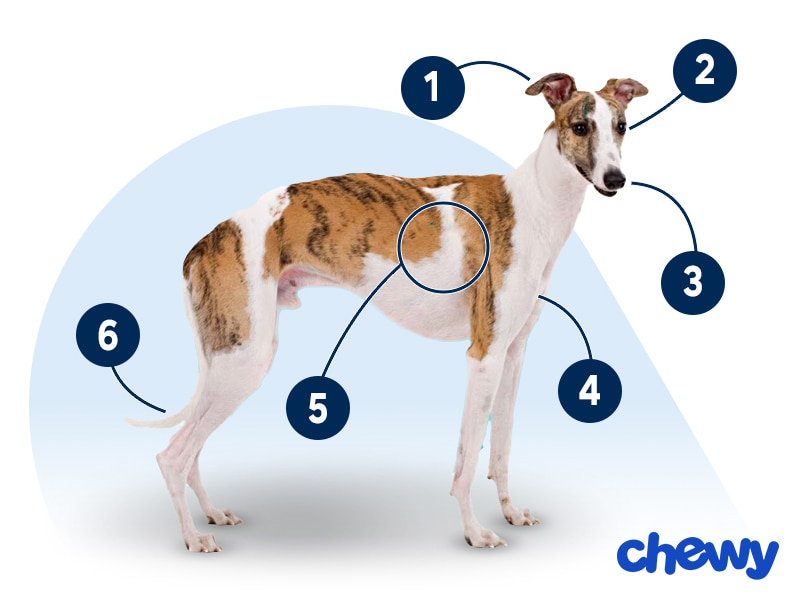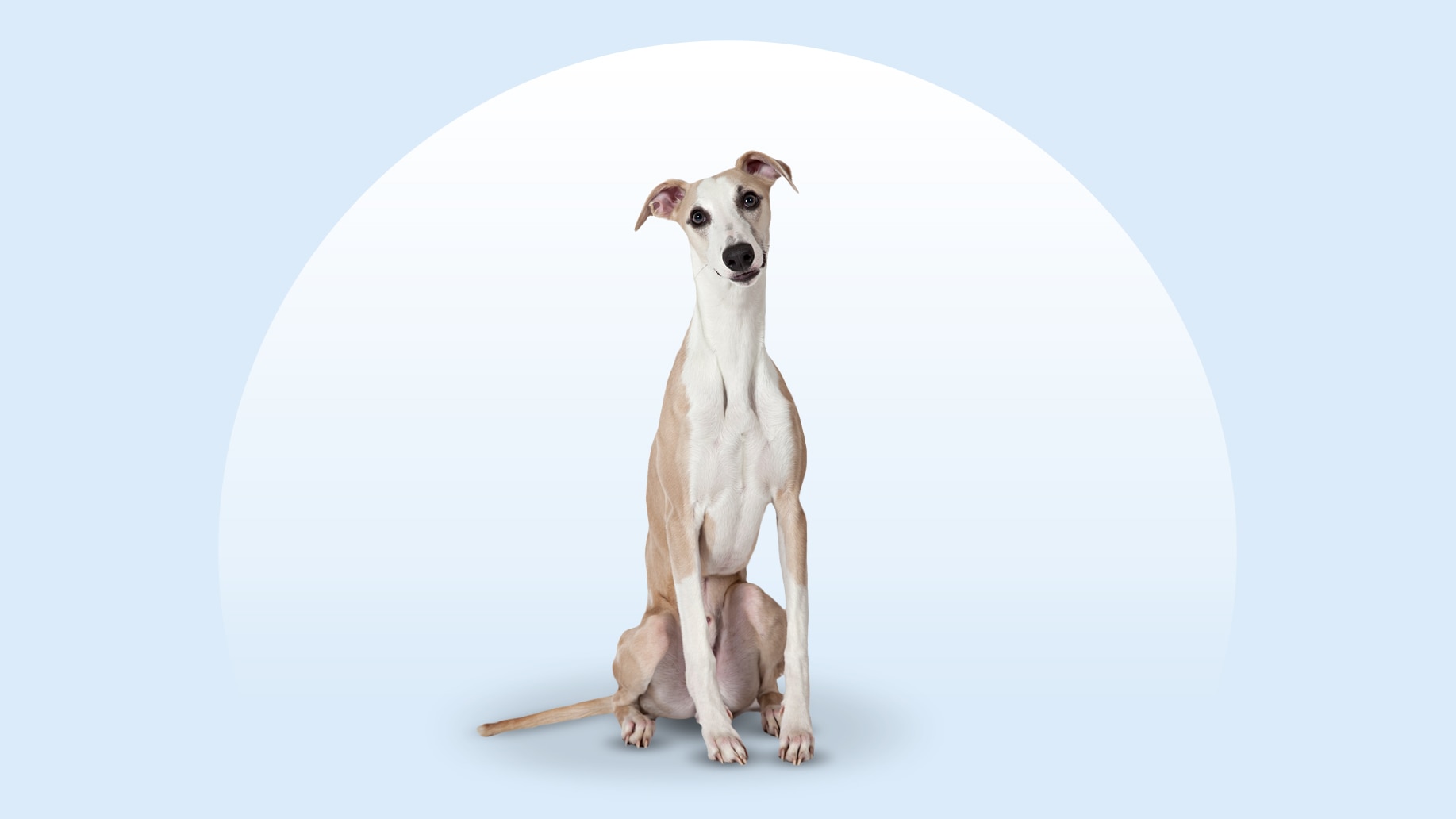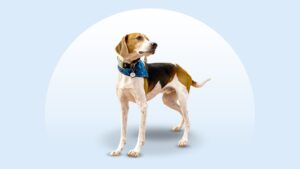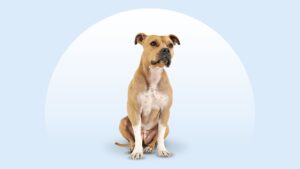Whippet
Updated October 24, 2025
Whippet
Updated October 24, 2025
Whippets are graceful, gentle pups who need to run—fast, and often. But once they work out their energy, they’re happy to snooze the rest of the day away at home. With minimal grooming needs and a friendly nature, these dogs can fit perfectly into all kinds of families.
Athletic, Intelligent, Sensitive
25–40 pounds
18–22 inches
12–15 years
Fawn, Cream, Black, Blue, White, Red, Blue Brindle, Blue Fawn, Fawn Brindle, White and Fawn, White and Red, Red Brindle, White and Blue Fawn, White and Black, White and Blue, White and Blue Brindle, White and Red Brindle, White and Fawn Brindle
Whippets love to run. When they’re not running, they’re thinking about running. And when they’re done running, they’re dreaming about running. But that doesn’t mean you need to love running like they do. They’re perfectly happy to have you cheer them on from the sidelines.
In fact, Whippet dogs glide through the air so effortlessly that you might think they need nothing else in the world to be happy. But you’d be wrong: These clever, social canines adore their people, and if you’re not there to snuggle with them, all is not right in their kingdom.
Whippet Characteristics
Whippet Appearance
Often mistaken for a Greyhound or Italian Greyhound, the Whippet is somewhere in the middle.
Their faces are full of expression with their alert, intelligent eyes and small, neatly folded ears. They have a natural curve to their body, which is useful for sprinting short distances. And while Whippets aren’t as tall as their Greyhound cousins, they carry themselves with a graceful dignity.

- Ears
Whippet dogs have small ears that fold over slightly behind themselves, called a rose ear. Even when their ears are at attention, they usually don't perk straight up.
- Eyes
They have dark brown, nearly black eyes that are round with an intelligent expression.
- Nose
Whippet noses are a solid color, ranging from dark blue to dark brown to black.
- Coat Length
Whippet coats are short and silky smooth on their heads, and firm across their backs.
- Coat Color
Whippet colors include fawn, red, blue, cream, and black. Some Whippets may also have brindled fur (subtle tiger stripes).
- Tail
Their tail is long and tapered at the end, with a slight upward curve. While walking or running, their tail is lower so they can use it to navigate, like a steering wheel.
Whippet Temperament
Whippets are bright and eager to learn, but these smart dogs also have an endearingly sensitive side.
Though they’re quiet dogs who rarely bark, Whippets are eager to say hello to new friends—and they’d love to be loved as much as they give.
Because they are so social, the Whippet dog breed may struggle with separation anxiety. If you’re gone for long periods, tap in a dog walker or pet sitter to help keep them company.
Whippet dogs are smart and crave mental stimulation. They were originally bred to work as hunting dogs, and today’s Whippets will still enjoy tracking games and games of chase in a fenced backyard. Running is an especially beloved activity.
Once they’ve exhausted their energy, Whippets can be a bit lazy at home. You’ll probably find them curled up in a dog bed or on a favorite spot on the couch.
How to Care for a Whippet
Whippets have minimal grooming needs, but you’ll spend plenty of time exercising with these cuties.
Grooming
Training
Diet
Exercise
Environment
Whippet Health
The average Whippet lifespan is 12–15 years. Here are some health issues to be aware of.
- Bloat and gastric dilatation-volvulus (GDV): Bloat is a dangerous condition that happens when the stomach gets distended with air and/or food. A serious complication of bloat is when the stomach twists on itself, cutting off blood supply to the organs. This is called gastric dilatation-volvulus, and symptoms include abdominal distension, restlessness, and dry heaving. If you notice these signs, go to the vet immediately.
- Corneal dystrophy: Whippets can have a condition called corneal dystrophy, where small white crystal deposits form in their corneas. It progresses slowly, and it’s fortunately not painful, but there’s also no cure. While it often leads to blindness, most dogs adapt well and still have wonderful, happy lives.
- Deafness: Deafness is often hereditary in Whippets and can occur in one or both ears. There’s no treatment, but most dogs acclimate well to the condition and lead a full, happy life.
- Heart issues: Whippets can be prone to heart murmurs and mitral valve disease, where the heart does not pump blood efficiently. A heart murmur can be the earliest sign of mitral valve disease, but other symptoms include exercise intolerance, a cough, heavy breathing, an inability to rest, and decreased appetite.
- Hypothyroidism: Common in Whippets, hypothyroidism includes symptoms like lethargy, hair loss, skin and ear infections, and weight gain. A blood test can diagnose it, and treatment is a daily oral medication.
- Progressive retinal atrophy (PRA): PRA leads to blindness in dogs, and while there is no cure, pups who lose their eyesight tend to adapt well and can still live full, happy lives.
- Von Willebrand disease: Whippets are susceptible to von Willebrand disease, a bleeding disorder where the blood doesn’t clot properly. Your veterinarian can test your dog for this. There’s no cure, so your vet may recommend a stress-free lifestyle and to avoid medications that interfere with clotting.
Whippet History
The Whippet dog breed didn’t get its name until the mid-1800s, but these dogs have probably been around for hundreds, if not thousands, of years.
You can find them in paintings and sculptures throughout the Middle Ages and the Renaissance, where they resemble small Greyhounds. In fact, several hundred years ago in Great Britain, people who couldn’t afford Greyhounds would keep Whippets, which is how they earned their nickname “the poor man’s Greyhound.”
Once used for hunting rabbits via sight, these gentle sight hounds now have better pursuits—like making their families feel happy and loved. The Whippet started showing up in New England with European immigrants in the 19th century, and in 1888, the American Kennel Club recognized the breed.
Whippet puppies tend to cost between $1,000–$2,500 or more. If you choose this route, pick a responsible breeder.
You can also adopt a Whippet, as there are many patiently waiting for their forever homes. Look for a local Whippet rescue or a sighthound rescue like Fast Friends Greyhound Adoption, check out your local animal shelter, or search Chewy’s database of adoptable dogs in your area.








